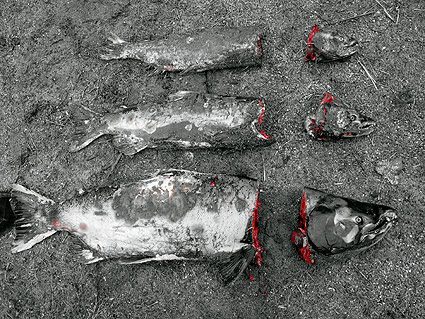Monday November 29, 2010

Although this looks like a scene from a gruesome horror flick, no fish were harmed while taking this photo. These Chinook salmon carcasses died naturally after spawning, and were photographed by one of our more creative biologists. The heads of these fish were collected to extract their otoliths (fish ear bones).
Otoliths are small mineral structures in which increments of calcium carbonate are accreted daily in thin concentric rings similar to the rings on a tree. Due to regional geologic variation, different areas can exhibit important differences in water chemistry. The growing surface of the otolith creates a chemical “fingerprint” of the area a fish inhabits. Using microchemistry and microstructure analysis techniques it is possible to distinguish between hatchery and wild fish and even discern movement throughout the fishes lifetime. A study of the natal origins of fall-run Chinook salmon from the Central Valley found that the origin of an adult Chinook can be identified with 82% accuracy based on the otolith microchemistry, and this accuracy can be improved if additional microstructure information is included (Barnett-Johnson et al. 2008).
Photo source: FISHBIO
